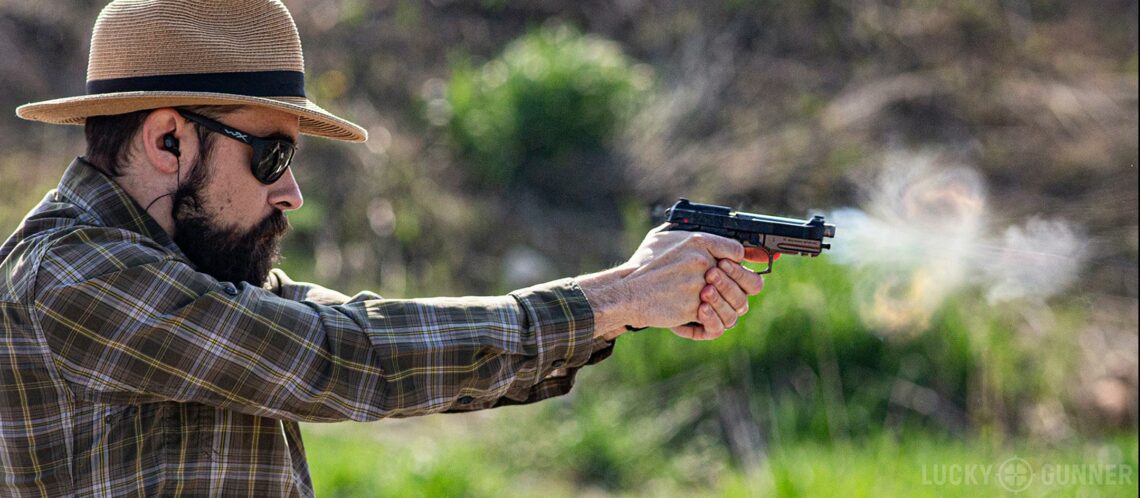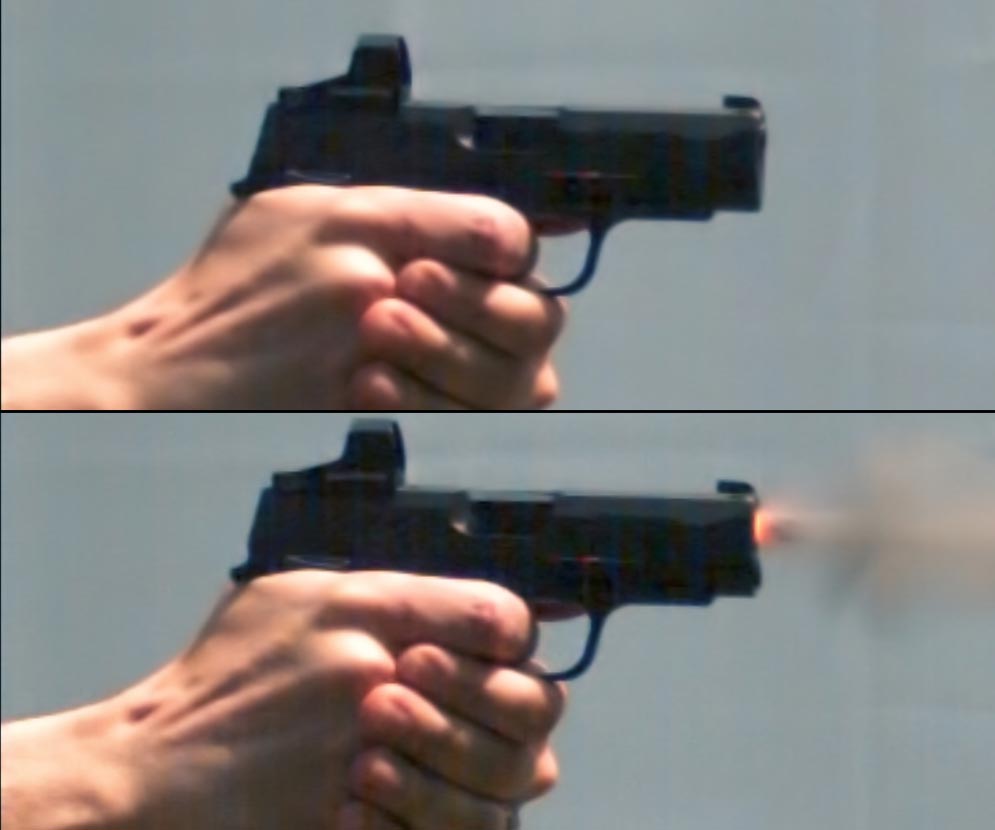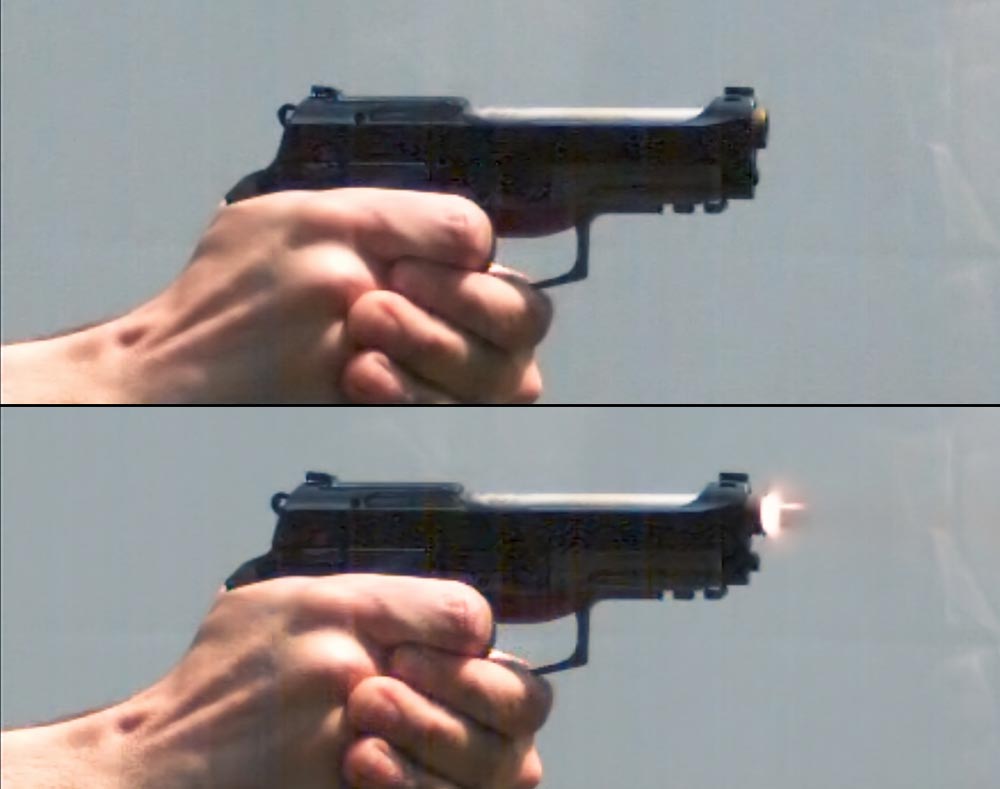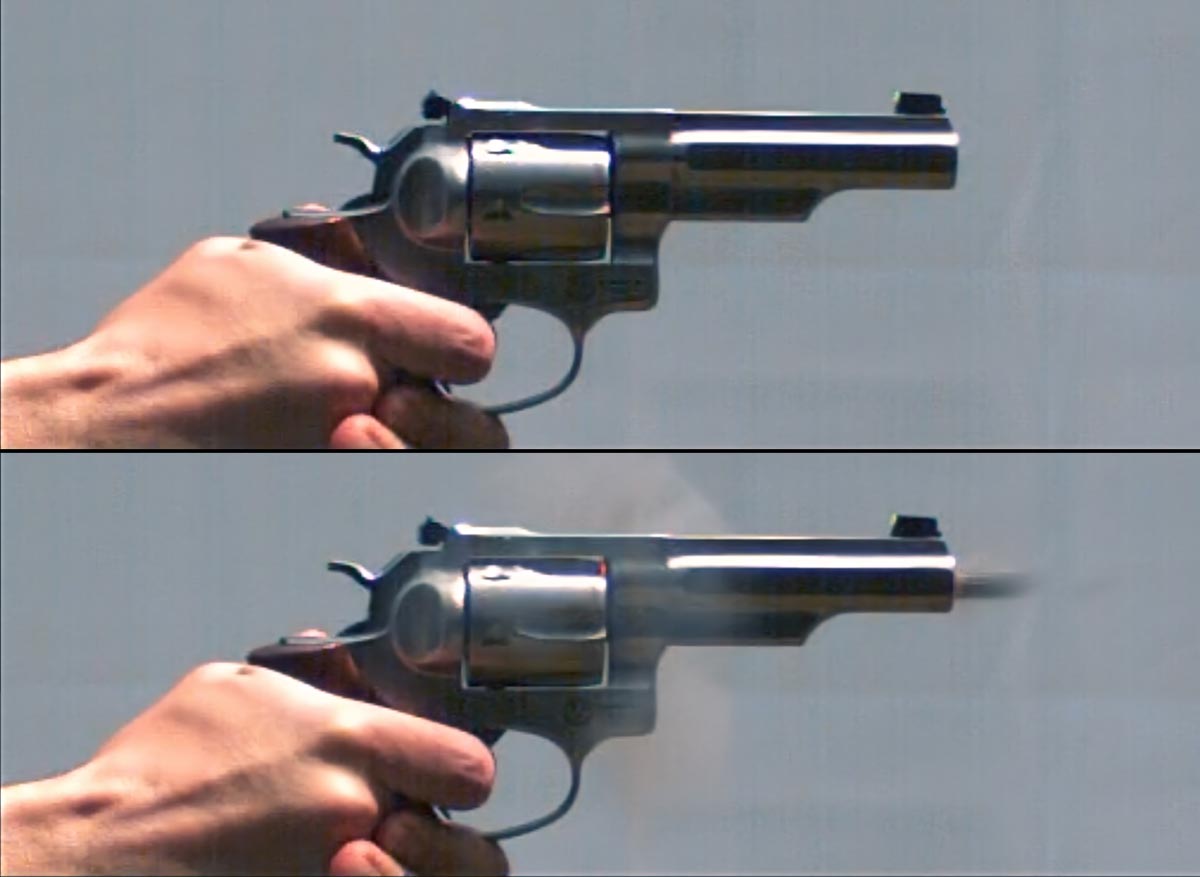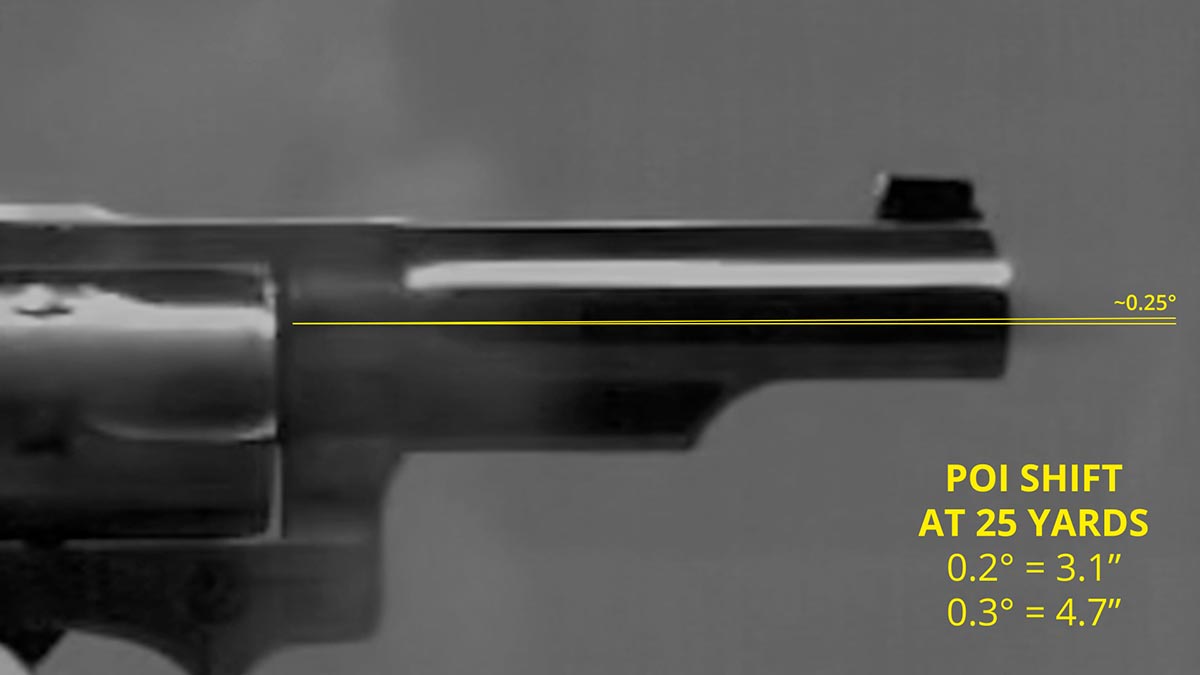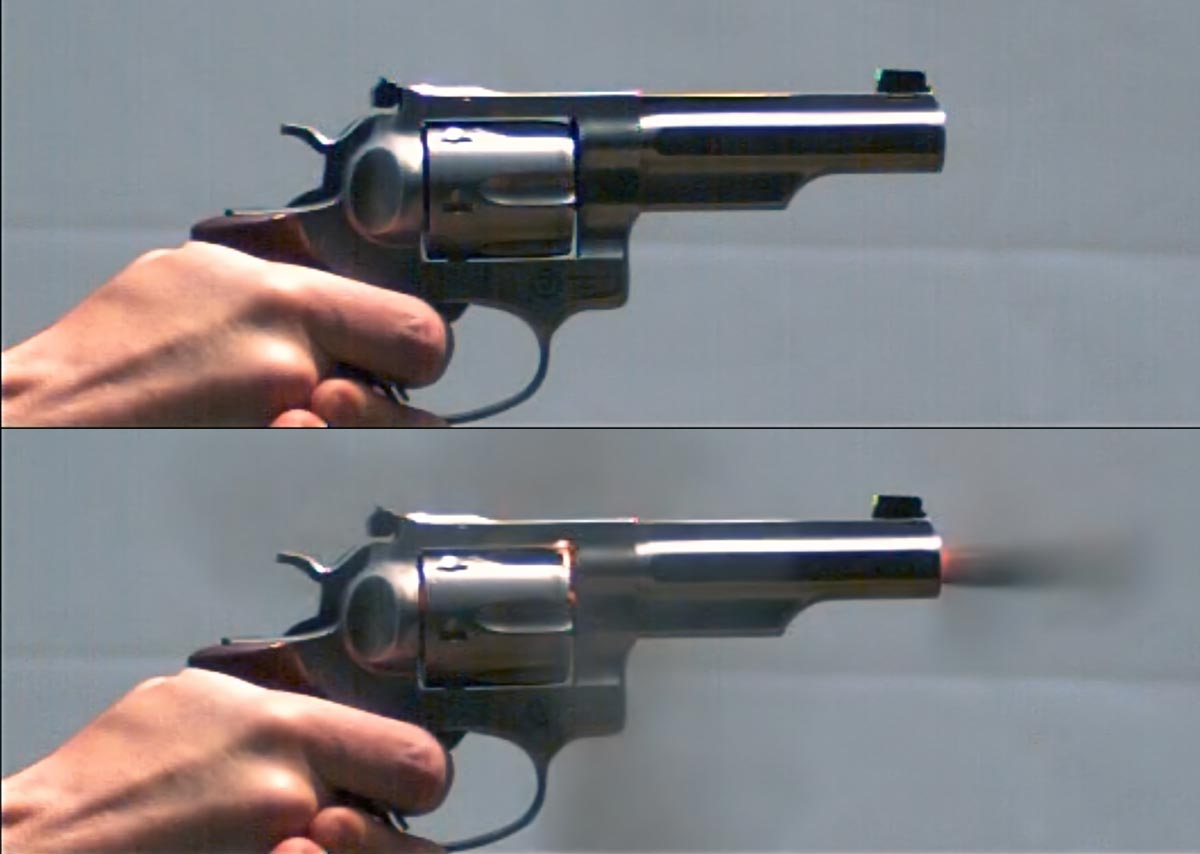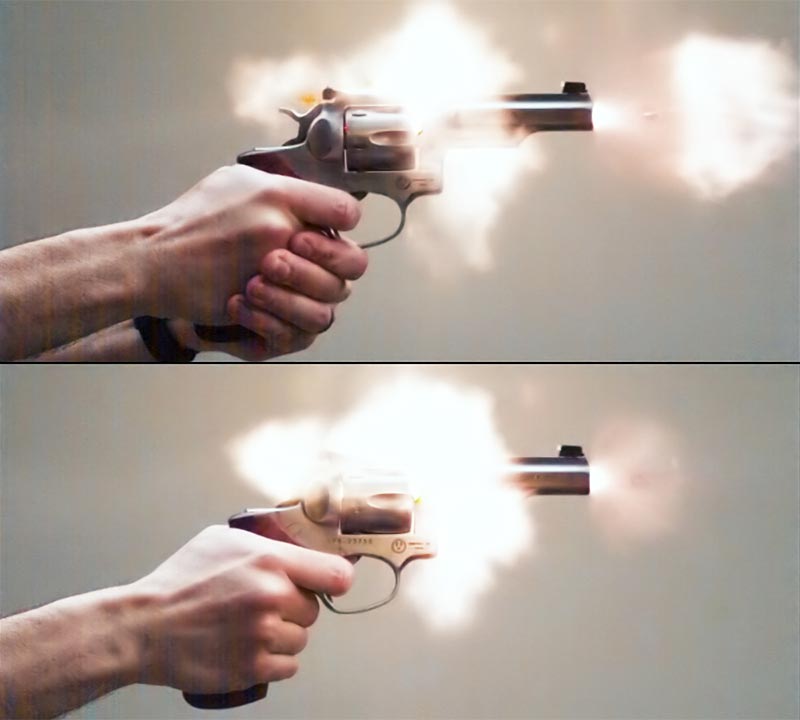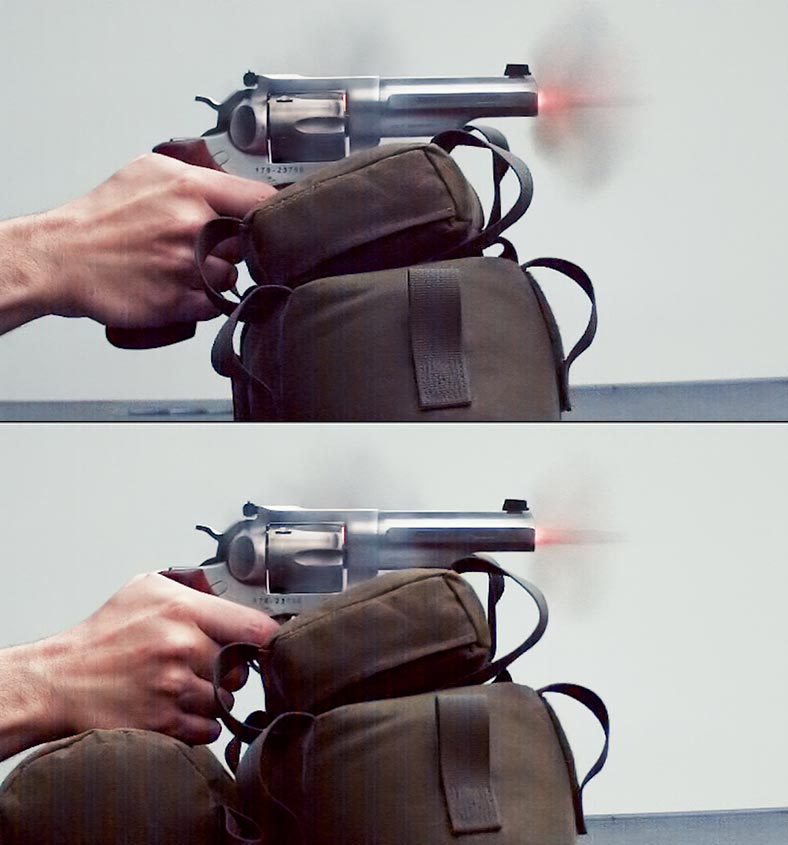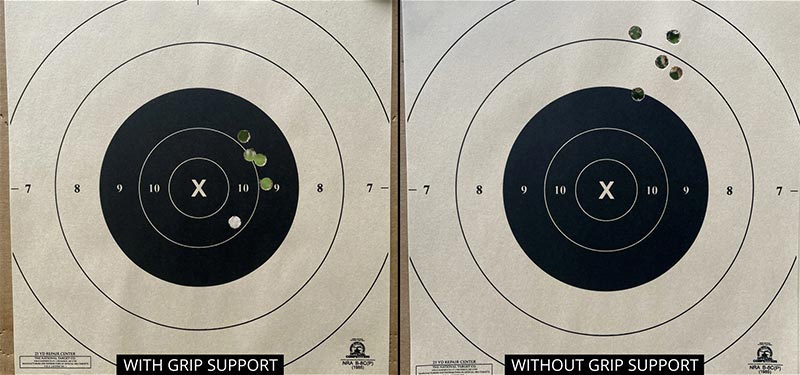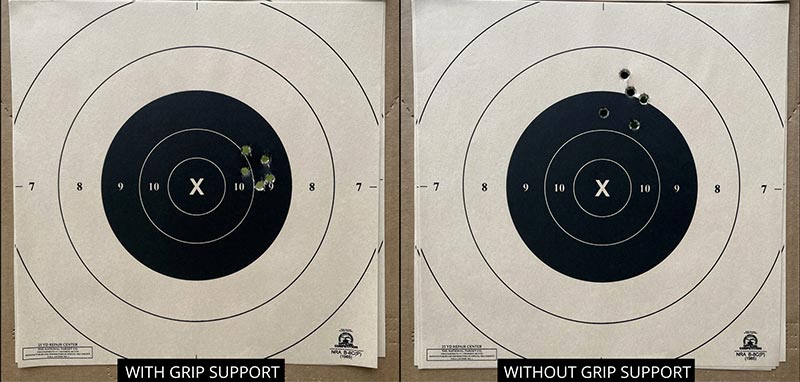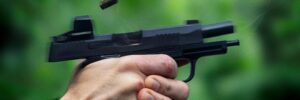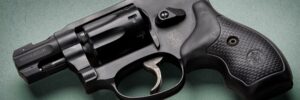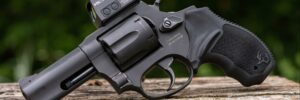Does recoil cause the muzzle to rise while the bullet is still in the barrel, or is the bullet long gone by then? Could a loose grip cause bullets to impact higher on the target? We used a high speed camera to help figure out what’s really going on in the eyeblink after you pull the trigger.
Details are in the video below, or scroll down to read the full transcript.
Hey everybody, I am Chris Baker from LuckyGunner.com and today we’re going to look at how recoil affects accuracy in handguns. Now, that’s a pretty broad topic. Practically speaking, there are lots of ways recoil affects accuracy. Most of them are related to the shooter’s technique. Recoil moves the sights off target and it can move the gun in our hand. It can cause recoil anticipation or pre-ignition push. We have to apply good shooting techniques to counteract those effects.
But today, I want to focus on an aspect of recoil that’s mostly out of our control. Does recoil have an objective, mechanical effect on the bullet’s point of impact? Or, to phrase it another way, does the muzzle begin to rise before the bullet leaves the barrel. And if so, does it rise enough to cause a noticeable change in where the bullet ends up?
I’ll go ahead and tell you up front that, regardless of the answer, there is not a whole lot of practical application here for the average shooter. This is something gun nerds debate on occasion. We’re going to have fun finding out the answer. But for shooting handguns at typical handgun distances, it doesn’t matter much. There are a couple of very narrow use-cases where it might come into play, and I’ll get to those at the end.
To aid us in our mostly useless quest, we’ve called upon some assistance from a Chronos 2.1-HD high speed camera. We did one batch of shots at 4370 frames per second, which is 182 times slower than real time. Then we did a second batch of shots with a lower resolution at just over 10,000 frames per second, or 437 times slower than real time. If we crank up the frame rate any higher than that, the resolution gets too fuzzy to really tell what’s going on.
Okay, back to our big question: does the bullet leave the barrel before the muzzle rises? It depends on the gun.
Semi-Autos
Let’s start with a semi-auto. This is a 9mm Sig P365 XL. I’ll just let it play through in real time first. And here it is in slow motion. There goes the bullet, and there’s plenty of recoil. The gun wants to move straight back. The shooter’s hand stops that rearward motion, so the gun takes the path of least resistance, which is up. The result is a rotational movement, or what we sometimes call muzzle rise.
But let’s go back and look at it frame by frame. Did that rotation start before the bullet exited the barrel? First, we see a little smoke, and then a couple of frames later… there we go. That gray blur there is the bullet. Let’s back it up one frame when we know for sure the bullet is still in the barrel. If we compare that to our last pre-ignition frame, we can see the slide and barrel have started to move to the rear while the bullet is still in the barrel, but we’re not seeing any of that rotational movement yet. There is no upward movement of the barrel. That doesn’t start until right about… here, and by then the bullet is already out of the frame.
So, for the Sig, at least, it looks like muzzle rise should not be a factor in the bullet’s point of impact.
Let’s look at another semi-auto. This is the new .380 Beretta Cheetah 80X that I’m in the process of reviewing. This gun has a straight blowback operated action. The Sig was recoil-operated. Let’s see if that makes any difference in when the muzzle rise begins.
There goes the hammer and there’s the bullet. Before I even go frame by frame, you could probably see what happened there. With a blowback pistol, the barrel doesn’t move with the slide, it stays locked to the frame. There’s the bullet right there. We back up a frame, compare it to the frame when the hammer stopped moving. There’s slide movement, but the barrel hasn’t moved at all. The rotational movement doesn’t begin until the slide is almost completely open.
Revolvers
Okay, you know what’s coming next. What about revolvers? We’ve got a Ruger GP100 and let’s start with a really mild load. This is a .38 Special 148-grain wadcutter from Black Hills. It’s puttering along at 660 feet per second with almost no muzzle flash, so it’s pretty easy to see. Let’s go frame by frame. There’s the bullet. Back up a frame. Compare it to the pre-ignition frame. There is definitely some rotational movement there while the bullet is still in the barrel.
But how much movement, and is it enough to really matter? I tried a half dozen different methods for measuring the change in the barrel’s angle and I wasn’t really satisfied with any of them. We would need a high speed camera capable of much higher resolution and framerate in order to measure that accurately. And that’s not in the budget right now.
But my best estimate is that the barrel moves roughly .2 to .3 degrees before the bullet exits. That doesn’t sound like much, but at 25 yards, that translates to a point of impact that’s between 3.1 and 4.7 inches higher than if the muzzle had remained in place.
So let’s say you locked the gun in some kind of mechanical rest so that it could not move, and you zeroed the sights to be dead-on at 25 yards. If you took the gun out and shot it with your hands, you would be hitting three to five inches high.
Now, that wadcutter was moving pretty slow. What if we tried a magnum round? Would it exit the barrel before the muzzle rises? This is a Remington 125-grain jacketed soft point moving at 1400 feet per second. It definitely spends less time in the barrel compared to the wadcutter. Only five frames versus nine. But there does still seem to be some rotational movement taking place before the bullet exits.
So muzzle rise does influence the point of impact for revolvers. The degree of that influence probably changes depending on the load you’re shooting, although it’s hard to see that in our high speed footage. But we know a slower bullet will spend longer in the barrel, which means it should rise more before the bullet exits. That’s at least one of the reasons slower bullets typically have a higher point of impact than faster ones.
Theoretically, a bullet that recoils more (like a magnum) might have more muzzle rise before the bullet exits. That could be a factor. But looking at the footage of our wadcutter and magnum, there is not much difference in the amount of rotational movement of the gun in that short period while the bullet is still in the barrel. I’m inclined to believe the amount of time the bullet spends in the barrel is more important than the magnitude of the recoil because most of that recoil happens after the bullet is gone.
Can Grip Influence Point of Impact Shift?
So what about grip? Does a firm grip cause less muzzle rise than a loose grip? I tried firing a magnum load with a firm two-handed grip and again with a loose one-handed grip. Obviously, the loose grip allowed a lot more rotation overall. I could not really tell a difference in the amount of movement before the bullet exited.
What I did notice is that no matter how hard I gripped the gun or how little or how much recoil the gun had, the grip appeared to move in my hand before my hand reacted. Our hands are covered in squishy things like skin, fat, and muscle, so they’re always going to have some give. Regardless of how tight you squeeze, the gun will be able to move at least a tiny bit before it encounters the full resistance of your grip.
Having said that, I did not want to dismiss grip as a possible factor in shifting the point of impact.
The Sandbag Test
So I tried Plan B. Instead of gripping the gun differently, I tried firing with sandbags for support. First, with only the frame of the gun supported, and then again with an additional sandbag under the grip. I compressed it down as much as possible so the grip was firmly planted on that sandbag. This is not the same as immobilizing the gun. The sandbag does not prevent that rotational movement, but I figured it would cause the gun to recoil in a different way. If that was enough to alter the point of impact, then I think it stands to reason that it’s at least possible that the way you grip the gun could also change the point of impact.
Here it is first without the bottom sandbag. The rotation looks pretty much the same as shooting unsupported. Now, with the bottom sandbag, it’s a little different. The gun moves back and then up. Again, this is not something I could easily measure and compare based on our high speed footage. Instead, I just shot some groups at 25 yards.
Here’s a five shot group with the Black Hills wadcutter at 25 yards. First with the bottom sandbag supporting the grip. And another group without the bottom support. That’s about three and a half inches higher than the first group. It looks like that bottom sandbag delayed the muzzle rise, which caused the lower point of impact.
And now the Remington 125-grain Magnum load. With grip support on the left, without it on the right. About two and a half inches higher. Same effect as the slower bullet, but with less muzzle rise, maybe because of less time in the barrel.
So what can we take away from all of this? For most of us, not much, except that shooting is fun and so are high speed cameras. But if you like to shoot revolvers at 25 yards and beyond, there might be something here. It’s probably a good idea to make sure your grip is unsupported if you zero your revolver from a bench rest. Always confirm your bench rest zero by shooting a couple of groups without the bench. Any time you’re shooting at those longer ranges, try to make sure you grip the gun exactly the same way every time. And of course, the next time you need some ammo, be sure to get it from us with lightning fast shipping at LuckyGunner.com.
